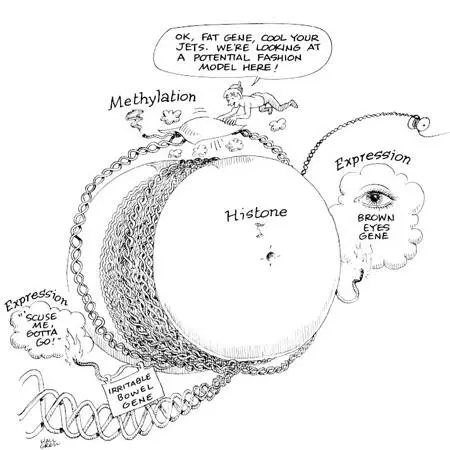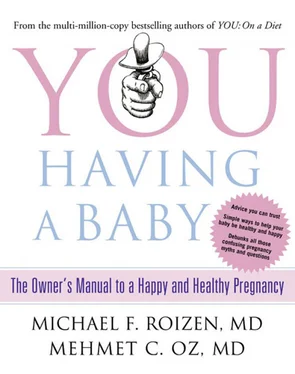In utero, if you feed your baby fewer nutrients, you’re programming your child to expect an environment of deprivation ex utero. So genes that cause the fetus to be very thrifty, metabolically speaking, are turned on. Once the baby is born and the external environment is not one of deprivation, that child will conserve more of the food it gets and become fatter, exhibiting what’s known as a thrifty phenotype (we refer to this in chapter 2). More fat storage equals an increased likelihood of becoming overweight and developing heart disease, type 2 diabetes, stroke, cancer, and osteoporosis as an adult. It’s similar to the reason why starvation diets don’t work: When your body thinks it’s faced with famine, it goes into fat-storage mode and your metabolism slows. Poor fetal nutrition may also permanently change the structure and development of vital organs such as the brain. In some cases, these epigenetic changes can even be passed on to future generations as well.
We do want to make one thing clear: If this is not your first pregnancy, don’t beat yourself up that you didn’t know much about epigenetics the last time around. None of us did, either. While epigenetics plays a role in what happens before birth, as we mentioned earlier, you can actually regulate gene activity after birth—for this child, for previous children, even for yourself. Also, if you fear you’ve already done something damaging to this baby, rest assured that human beings are a resilient lot; otherwise we’d have died out millennia ago. Let’s face it: Since 50 percent of pregnancies are unplanned, plenty of women inadvertently expose their babies to toxins like alcohol and tobacco. The key is to stop and make a YOU-turn, * reversing damaging behavior as soon as possible. Even the damage caused by smoking can be offset if you quit in the early part of your pregnancy.

Figure 1.5 Time for Change Through processes called methylation and acetylation, you can alter the way genes are expressed, as well as determine which genes are expressed. In other words, you can take certain actions that will influence whether some genes come to the forefront and whether others get locked away forever.
Another way to think about how epigenetics works is to think about how music is created. Consider your DNA to be the musical composition that will determine the individuality of your child; after all, there are zillions of way to put musical notes together. But the catch is that there are many different ways to interpret any given song. The way Johnny Cash sang a song would be different from the way a rocker would today and is way different from how a philharmonic orchestra would perform it. † Same song, different interpretations, and different results.
You and your partner each has your own set of DNA, and through your recent rendition of a boogie-woogie-woogie, you made your own biological song in the form of a baby. That genetic coding is indeed fixed, but you still have the ability to interpret the song and change the way your offspring’s genes are expressed. That, dear friends, should be music to your ears.
* Please cue “Let’s Get It On” by Marvin Gaye.
* Interestingly, too little of these hormones may lead to infertility or miscarriage, while an abundance may lead to twins and other multiple sets. More on this in “Fertility Issues” on page 380.
* True statement, not a joke.
* A YOU-Turn, as we introduced in YOU: On a Diet , refers to the fact that it’s not too late to make changes. The key is to identify when you’ve gone down the wrong road and get back on the right course as soon as you can.
† Not that one would.
Конец ознакомительного фрагмента.
Текст предоставлен ООО «ЛитРес».
Прочитайте эту книгу целиком, купив полную легальную версию на ЛитРес.
Безопасно оплатить книгу можно банковской картой Visa, MasterCard, Maestro, со счета мобильного телефона, с платежного терминала, в салоне МТС или Связной, через PayPal, WebMoney, Яндекс.Деньги, QIWI Кошелек, бонусными картами или другим удобным Вам способом.













